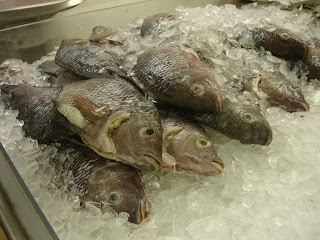
Sorry to have waited till our return to finish off the blog, however, we did make it home safely. After finishing the pre-front transects, we spent 24 hours following the drogue and the plankton mimics while the front came in. We successfully recaptured the mimics after their longest open water trial. While we had expected bad storms with the incoming front, we were pleasantly surprised. The temperature did drop considerably, but the seas remained calm all but one evening.
Unfortunately, the crane broke and we were unable to collect cores after Sunday. We also lost the ability to put the small boat over the side in order to do more diving trips until the last day.
We re-occupied the two transects sampled prior to the front. We collected water samples from each of the 8 stations along each of the two transects for net tows and chlorophyll and HPLC filtering and nutrient analyses. Further Acrobat scanning was also performed during this time.
After travelling back toward the port of Pensacola, we attempted to locate a tripod that had been deployed prior to the hurricane season using hydrophones, but to no avail. Blake Schaeffer at the EPA will instead use side scan sonar to locate it. After trying to find the tripod, the divers were able to get out once more near the Port of Pensacola to obtain nutrient samples 2m off the bottom of the water column using the microsamplers.
We unloaded the boat upon our return Tuesday morning and the vans departed. Group 1 arrived back in Raleigh, NC Wednesday morning around 3am after driving straight through. Group 2 had to return via Wilmington to return the UNCW scientists and equipment, and so had a stopover north of Atlanta Tuesday night, and returned to Raleigh around 7pm Wednesday.














